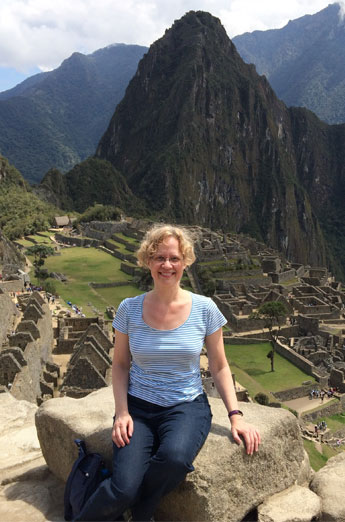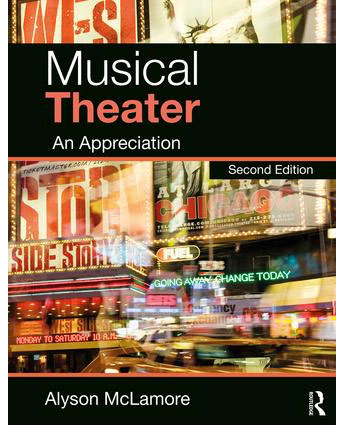In this section:
Meredith Brammeier
 Meredith Brammeier spent the past year traveling, composing and performing while on sabbatical. In June 2016, she performed the piano part of her Sonata for Horn and Piano at its premiere at the 48th Annual International Horn Symposium in Ithaca, New York. Immediately following this performance, she flew to Europe to join the Cal Poly Symphony, where her setting of text from Shakespeare’s “King Lear” for chorus and orchestra, “Blow, Winds, Rage, Blow!” was performed by the symphony and local choirs in Vienna and Prague.
Meredith Brammeier spent the past year traveling, composing and performing while on sabbatical. In June 2016, she performed the piano part of her Sonata for Horn and Piano at its premiere at the 48th Annual International Horn Symposium in Ithaca, New York. Immediately following this performance, she flew to Europe to join the Cal Poly Symphony, where her setting of text from Shakespeare’s “King Lear” for chorus and orchestra, “Blow, Winds, Rage, Blow!” was performed by the symphony and local choirs in Vienna and Prague.
In the fall, Brammeier journeyed to Peru, where she visited friends in Lima and took a solo trip through the Andes that included Machu Picchu, Lake Titicaca and many other fascinating sites. After returning to the U.S., she traveled to Nashville, Tennessee, for the North American premiere of her composition “Elegy” by Vox Grata Women’s Choir.
Brammeier was awarded composer residencies at the Kimmel Harding Nelson (KHN) Center for the Arts in Nebraska City, Nebraska, and at the Virginia Center for the Creative Arts in Amherst, Virginia, where she worked on a number of vocal and instrumental compositions. At the beginning of March, she sang in the semi-finals of the Harold Haugh Light Opera Vocal Competition in Jackson, Michigan. After a brief stop in Chicago, she embarked on a musical pilgrimage through Germany and Italy, visiting the places where J.S. Bach and many other composers lived and worked, and exploring her Germanic Lutheran roots.
In June 2017, Brammeier joined the Cal Poly Choir tour to London and Wales, where the choir performed her newest choral composition, a setting of Gerard Manley Hopkins’ poem “God’s Grandeur” that she completed at the KHN residency. This fall, she has returned to the classrooms of the Davidson Music Center and is enjoying sharing stories of her sabbatical adventures with the faculty, staff and students.
India D'Avignon
India D'Avignon recently returned to teaching after a rejuvenating sabbatical year. It began when she and her husband relived the 1960s at the Desert Trip Fest in Palm Springs where they heard Bob Dylan, the Rolling Stones, The Who, Paul McCartney, Graham Nash and Roger Waters. She attended the Association of International Educators (NAFSA) Conference in Denver, Colorado, and the National Group Piano and Piano Pedagogy Forum in Oberlin, Ohio, before presenting several papers. The first was in Seville, Spain, where she co-presented the paper, “Learn by Doing: A Successful Paradigm for Undergraduate Education” at the iCERi Conference. Her next presentation was in Long Beach for the Phi Beta Delta International Conference, titled “An International Exchange Program Between Piano Students from the USA, Poland and Ukraine.” Spain was her destination again to present in Valencia, “Delivering an Innovative Music Curriculum at a Polytechnic University,” for the International Technology, Education and Development Conference. She took a side trip to visit the Gaudí architecture and decorative arts in Barcelona. She highlighted her research with a presentation titled “Franklin, Mozart, Mesmer and the Glass Armonica,” at the World Conference on Fraternalism at the National Library of France in Paris. While in Paris, she attended many concerts in some of the most beautiful venues in Europe: Mozart’s Requiem and Schubert Mass in La Madeleine Church; Vivaldi in La Saint Chapelle; and Gregorian chant and medieval music in the Notre Dame cathedral. In between these presentations, she worked on and finished her piano method book “Piano for Adults” and is currently using it with her beginning piano classes at Cal Poly. Prior to the start of school, she enjoyed Garth Brooks, “La La Land” accompanied live by the San Diego Symphony, James Taylor and Bonnie Raitt at AT&T Park, Gipsy Kings, and a John Williams music concert at the Hollywood Bowl to round out her music emersion year. It was a productive year, and she extends her sincere thanks to all her colleagues who supported her sabbatical and filled any gaps while she was gone.
Ken Habib
Ken Habib led the Cal Poly Arab Music Ensemble on a concert tour to the Middlebury Institute of International Studies at Monterey (MIIS) on April 21 to give a concert and lecture-demonstration in Irvine Auditorium. The ensemble presented traditional and contemporary music from the Eastern Mediterranean and North Africa for the MIIS Arabic Studies Program, directed by Mahmoud Abdalla. San Luis Obispo dance director Jenna Mitchell led the troupe of dancers that joined the Arab Music Ensemble on the tour.
In the summer of 2017, and on the heels of giving an enthusiastically received concert for the Middlebury at Mills Arabic Language School in the summer of 2016, Habib again produced and performed the major musical event of the summer in Littlefield Concert Hall at Mills College with his professional group, Ensemble Salam. In addition to his performing on oud, buzuq, guitar and voice, the septet featured Ishmael on qanun, Elias Lammam on accordion and voice, Fathi Aljarrah on violin and voice, Maram Dagher on lead vocals and percussion, Bridget Robbins on nay, and Faisal Zedan on riqq, daff, darabukka and voice.
Jacalyn Kreitzer
Jacalyn Kreitzer attended a conference in Palm Springs at the end of October for further education on a subject near and dear to her heart: healing injured voices. It was presented by the SongShine Foundation, an institution that provides music, speech and creative drama-based voice therapy for singers and speakers with granuloma (pre-nodes), nodes, injury from aging and strokes, Parkinson’s disease and other neurological disorders. Kreitzer has committed herself to helping singers and speakers to naturally heal their voices, understanding how devastating it can be to lose the ability to speak or sing clearly or communicate effectively.
Kreitzer teaches vocalists in all genres — classical, opera, musical theatre, alternative and jazz — and considers herself a holistic teacher. A student of the National Institute of Voice, she offers holistic tools to heal voices, including: music, body awareness, breath management, imagination, diction, creative drama, role playing, emotional engagement, yoga, self esteem, anxiety management and vocal health. Kreitzer also includes the use of “primal sounds” to achieve natural results, and the “belt” technique, noting musical theatre singers as well as lecturers and speakers can particularly benefit from the methods. The conference further strengthened her training, and put more healing vocal tools to repair voices in her tool bag.
Alyson McLamore
 Alyson McLamore is pleased to announce the launch of the second edition of her textbook “Musical Theater: An Appreciation,” published by Routledge in September 2017. The new edition has expanded to include musicals from the past 14 years, but it also reflects the explosion of scholarly attention that has been focused on older repertory. The book now contains detailed listening charts correlated to specific recordings, as well as several new musical examples.
Alyson McLamore is pleased to announce the launch of the second edition of her textbook “Musical Theater: An Appreciation,” published by Routledge in September 2017. The new edition has expanded to include musicals from the past 14 years, but it also reflects the explosion of scholarly attention that has been focused on older repertory. The book now contains detailed listening charts correlated to specific recordings, as well as several new musical examples.
Besides editing textbook proofs during the summer of 2017, McLamore also enjoyed traveling with W. Terrence Spiller, Meredith Brammeier, and a host of current and former vocalists who performed during Tom and Susan Davies’ “farewell” choir tour through Great Britain. McLamore also journeyed to New York in July to participate in a Mozart Society of America panel, a feature of the Mostly Mozart Festival at Lincoln Center. McLamore’s presentation, titled “Mozart in the Middle: London’s ‘Musical Children,’” examined the youthful peers Mozart encountered when he visited England at age 8.
